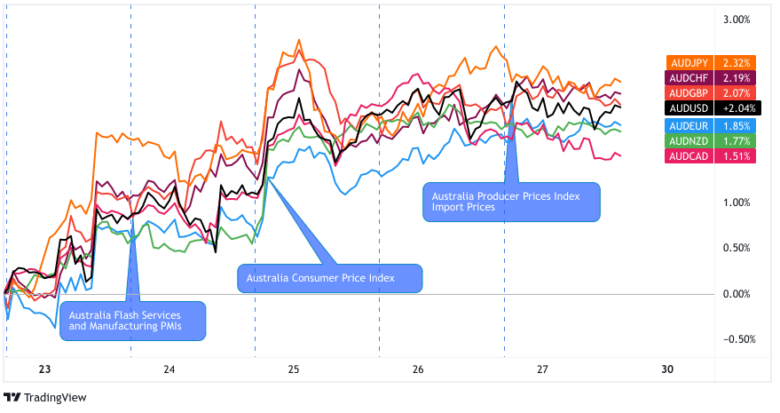We’ll get the latest Australian inflation update on Wednesday, which may be a big short-term influence on the Aussie this week. Check out all of the important data to consider before putting together your latest trade idea!
Event in Focus:
Australia Quarterly Consumer Price Index for Q1 2023
When Will it Be Released:
April 26, 2023, Wednesday: 1:30 am GMT, 2:30 am London, 10:30 am Tokyo, 9:30 pm (Apr. 25) New York
Expectations:
Australia Consumer Price Index Y/Y: 6.8% forecast vs. 7.8% previous
Australia Consumer Price Index Q/Q: 1.2% forecast vs. 1.9% previous
Relevant Data Since Last Event/Data Release:
- Australia Manufacturing PMI Survey for March: Respondents said that price pressures alleviated in March with rates for both input cost and output price inflation falling.
- Australian Bureau of Statistics February CPI report: 6.8% y/y vs. 7.4% y/y read in January
- Australia Composite PMI for February: “Prices pressures eased further in the service industries yet remain elevated, while manufacturing price indicators barely moved in February. Despite the moderation, the price indicators continue to point to above target inflation in 2023.”
Previous Releases and Risk Environment Influence on the British Pound
Jan 25, 2023
Event results / Price Action:
The Q4 2023 Australian headline CPI update came in hot as it was above both forecast (+1.6% q/q) and the Q3 read (+1.8% q/q) at 1.9% q/q. The annualized rate increased to 7.8% vs. 7.3% previous, The Aussie immediately jumped against all of the majors to intraweek highs after the release.
Risk environment and intermarket behaviors:
Intermarket price action was relatively mixed during this week in January, but the broad risk sentiment lean seemed to have favored risk-on behavior as equities, crypto and bond yields ended the week in the green, while gold and USD was flat. This likely reflected speculation that the Fed may slow the pace of rate hikes after a streak of weaker-than-expected U.S. economic updates.
October 26, 2022:
Event results / Price Action:
The Q3 Australian headline CPI update came inline with the previous quarter read (+1.8% q/q) at 1.8% q/q; while the annualized rate increased to 7.3% vs. 6.1% previous. It appears that this was enough to keep up speculation of another rate hike from the Reserve Bank of Australia at the time, characterized by the rally in AUD through the London and U.S. sessions.
Risk environment and intermarket behaviors:
Broad market volatility this week in October was largely influenced by weaker-than-expected data from China and the U.S., which strengthened the argument for central banks to slow the pace of monetary policy tightening.
This idea was likely the reason for price sentiment to have mainly leaned risk-on, signaled by the rise in equities and oil prices vs. red closes in gold, the U.S. dollar and bond yields.
Price action probabilities:
Risk sentiment probabilities:
This week’s broad market focus is likely on the latest global CPI and GDP updates, and based on the economic calendar, expectations are for both economic metrics to come in below previous reads on net.
If indeed we do see inflation and GDP metrics lower, that makes the case for slower central bank tightening (or even pivot) arguments, but also raises recession expectations.
Based on recent price action, recession fears seem to be the top influence, so it is possible this week’s economic updates could potentially push risk assets generally lower.
Now, there is a possibility that inflation updates could surprise to the upside, as we saw in the U.K. last week, which may shift broad focus back to inflation data/monetary policy consequences on the session.
Australia Dollar scenarios:
Potential Base Scenario:
Based on the past two releases, this is likely to be a very volatile event for the Australian dollar and strong odds of a directional bias.
And with expectations for Australian CPI to slow, and the broad markets likely to lean risk-off focusing on recession worries, the Aussie may see pressure this week, even before the CPI event.
In this potentially bearish AUD scenario, take a deeper look at AUD/USD and EUR/AUD for short AUD technical setups and opportunities as both the Federal Reserve and European Central Bank are seen to stay tough on fighting inflation for now.
Potential Alternative Scenario:
In the low probability scenario of Australian inflation coming in hot, look for the Aussie to pop higher, even if broad risk sentiment is generally negative.
In this scenario, a rally would probably be short-lived as traders may take some quick profits on a spike higher given the recent negative shift on the Aussie over the past week.
Additionally, if we see broad risk sentiment leaning positive on a fresh catalyst, then that may be the best situation to look at long AUD opportunities against the “safe havens,” i.e., check out the charts in AUD/JPY and AUD/CHF to see if any technical setups arise.











